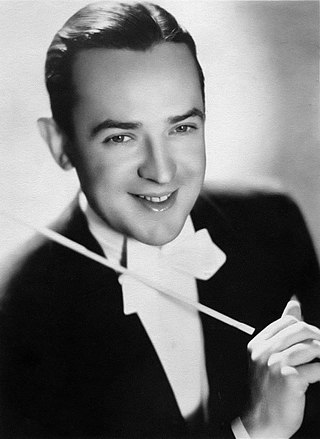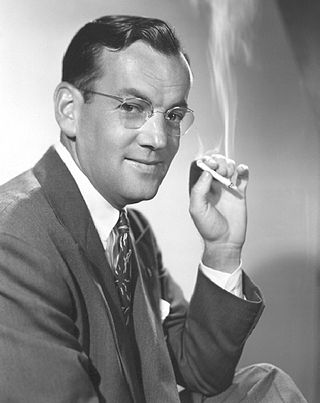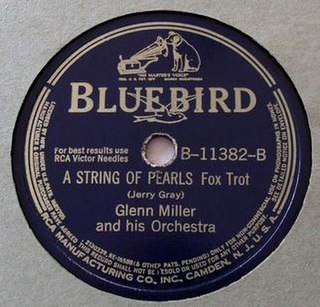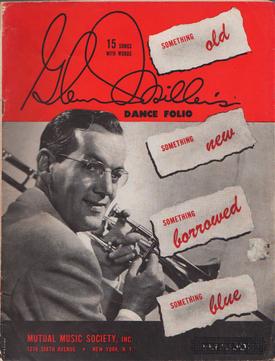
Alton Glen "Glenn" Miller was an American big band conductor, arranger, composer, trombone player, and recording artist before and during World War II, when he was an officer in the US Army Air Forces. His civilian band, Glenn Miller and His Orchestra were one of the most popular and successful bands of the 20th century and the big band era. His military group, the Major Glenn Miller Army Air Forces Orchestra, was also popular and successful.

James Francis Dorsey was an American jazz clarinetist, saxophonist, composer and big band leader. He recorded and composed the jazz and pop standards "I'm Glad There Is You " and "It's The Dreamer In Me". His other major recordings were "Tailspin", "John Silver", "So Many Times", "Amapola", "Brazil ", "Pennies from Heaven" with Bing Crosby, Louis Armstrong, and Frances Langford, "Grand Central Getaway", and "So Rare". He played clarinet on the seminal jazz standards "Singin' the Blues" in 1927 and the original 1930 recording of "Georgia on My Mind", which were inducted into the Grammy Hall of Fame.

"In the Mood" is a popular big band-era jazz standard recorded by American bandleader Glenn Miller. "In the Mood" is based on the composition "Tar Paper Stomp" by Wingy Manone. The first recording under the name "In the Mood" was released by Edgar Hayes & His Orchestra in 1938.

"Chattanooga Choo Choo" is a 1941 song written by Mack Gordon and composed by Harry Warren. It was originally recorded as a big band/swing tune by Glenn Miller and His Orchestra and featured in the 1941 movie Sun Valley Serenade. It was the first song to receive a gold record, presented by RCA Victor in 1942, for sales of 1.2 million copies.

Glenn Miller and His Orchestra were an American swing dance band formed by Glenn Miller in 1938. Arranged around a clarinet and tenor saxophone playing melody, and three other saxophones playing harmony, the band became the most popular and commercially successful dance orchestra of the swing era and one of the greatest singles charting acts of the 20th century. As of 2024, Ray Anthony is the last surviving member of the orchestra.

"(I've Got a Gal in) Kalamazoo" is a #1 popular song recorded by Glenn Miller and His Orchestra in 1942. It was written by Mack Gordon and Harry Warren and published in 1942. It was featured in the musical film Orchestra Wives and was recorded by Glenn Miller and His Orchestra, featuring Tex Beneke, Marion Hutton and The Modernaires, who released it as an A side 78 in 1942, 27934-A. The B side was "At Last".

Between 1938 and 1944, Glenn Miller and His Orchestra released 266 singles on the monaural ten-inch shellac 78 rpm format. Their studio output comprised a variety of musical styles inside of the Swing genre, including ballads, band chants, dance instrumentals, novelty tracks, songs adapted from motion pictures, and, as the Second World War approached, patriotic music.

"Sunrise Serenade" is a jazz song written by Frankie Carle with lyrics by Jack Lawrence. It was first recorded in 1939 by Glen Gray and the Casa Loma Orchestra with Carle on piano as Decca 2321. It soon became Carle's signature piece. Glenn Miller released a famous recording of it a few months later, arranged by Bill Finnegan, with "Moonlight Serenade" on the backside.

Annie's Cousin Fannie, which is sometimes listed as "Annie's Cousin Fanny", is a 1934 song composed by Glenn Miller and recorded by The Dorsey Brothers Orchestra for Brunswick and Decca Records. The Dorsey Brothers released two versions of the song in 1934 and 1935.

Boom Shot is a 1942 song composed by Glenn Miller and Billy May for the 20th Century Fox movie Orchestra Wives starring George Montgomery and Ann Rutherford.

"A String of Pearls" is a 1941 song recorded by Glenn Miller and His Orchestra on RCA Bluebird that November, becoming a #1 hit. It was composed by Jerry Gray with lyrics by Eddie DeLange. The song is a big band and jazz standard.

"I'm Headin' For California" is a 1944 song composed by Glenn Miller and Arthur Malvin and performed for radio broadcast. The song was released in 1946 as a 78 single by the Glenn Miller Orchestra led by Tex Beneke. The song was Glenn's last composition.

"I Sustain the Wings" is a 1943 big band and jazz instrumental co-written by Glenn Miller. The instrumental was the theme for the eponymous radio program broadcast on CBS and NBC from 1943 to 1945.

"It Must Be Jelly ('Cause Jam Don't Shake Like That)" is a 1942 jazz and pop song recorded by Glenn Miller and His Orchestra. The song was released as an RCA 78 single by Glenn Miller in 1944. Woody Herman also released the song as a single and as a V-Disc.

"Here We Go Again" is a swing jazz instrumental recorded by Glenn Miller. The song was released as a 78 single. It was Glenn Miller's last Top 40 hit during his lifetime, peaking at #25.

"Elmer's Tune" is a 1941 big band and jazz standard written by Elmer Albrecht, Dick Jurgens and Sammy Gallop. Glenn Miller and his Orchestra and Dick Jurgens and his Orchestra both charted with recordings of the composition.

"Harlem Chapel Chimes" is a 1935 jazz instrumental composed by Glenn Miller. The song was released as an A-side 78 single by the Dorsey Brothers Orchestra.
The Glenn Miller Orchestra is a band formed after the loss of Glenn Miller, named in memory of him and the original Glenn Miller Orchestra.

Pure Gold is a 1975 compilation album of 10 studio recordings by Glenn Miller and his Orchestra recorded between 1939 and 1942 by RCA Victor. The recordings were all originally issued as 78 RPM records on the RCA Bluebird and Victor labels and was certified Gold by the RIAA. The album was originally issued on LP and compact disc in reprocessed (fake) stereo sound; in 1988, RCA remastered the album in original monophonic sound for its second CD reissue. The album was also reissued on LP that year under a new catalog number (7648-1-R) and inexplicably omits two tracks, both of which appear on the reissued CD.



















